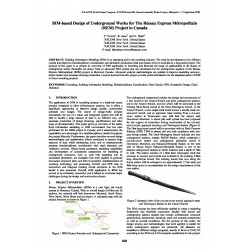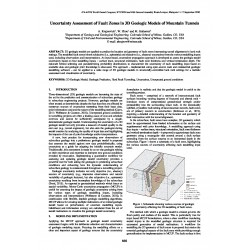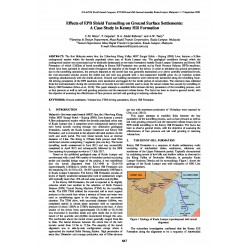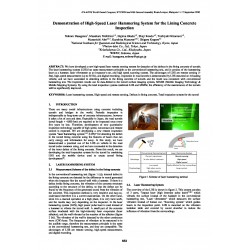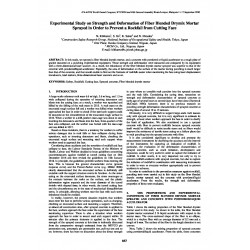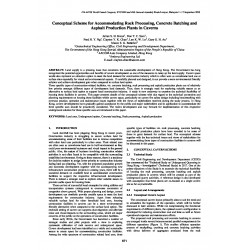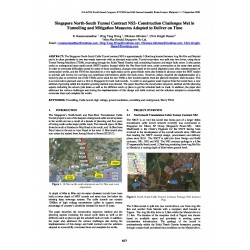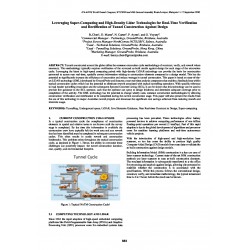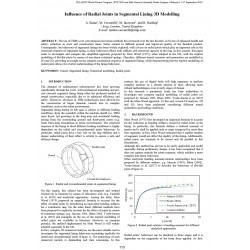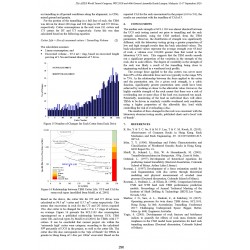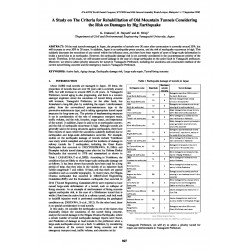No document
Search & filter
Search for a publication
Search & filter
World Tunnelling Congress
WTCThere are 1984 documents.
-
BIM-Based Design of Underground Works for the Réseau Express Métropolitain (REM) Project in Canada
Abstract: Building Information Modeling (BIM) is an emerging tool in the tunneling industry. The need for development of an efficient system that improves interdisciplinary coordination and minimizes production time and human errors is essential in a fast-paced project. The purpose of this paper is to present an overview of BIM application in tunneling and illustrate the range of applicability in all...
0,00 € -
Investigations into Heaving of Railway Roadbed in Mountain Tunnels and Effect of Countermeasure Work
Abstract: This paper outlines long-term investigations on heaving in railway roadbeds as seen in mountain tunnels and effectiveness of countermeasures. Roadbed heaving and track upheaval have been confirmed in certain tunnels. The heaving did not stop despite track maintenance intended to mitigate it. Furthermore, heaving tended to progress at specific locations. Through detailed and long-term...
0,00 € -
Uncertainty Assessment of Fault Zones in 3D Geologic Models of Mountain Tunnels
Abstract: 3D geologic models are applied to predict the location and geometry of fault zones intersecting tunnel alignments in hard rock settings. The modelled fault zones inherit subjective (i.e., epistemic) and objective (i.e., aleatory) uncertainty from the various modelling inputs used, including observations and interpretations. An input-based, uncertainty propagation approach is developed to assess...
0,00 € -
Strategic Underground Space and Cavern Development
Abstract: The use of underground spaces is becoming increasingly interesting, as surface space in cities becomes sparse and precious. Climate change increases the need for cities to protect themselves from flooding, major storms etc. Underground spaces can make cities more resilient to master these disasters and to keep functioning, by hosting vital services, like power distribution, fresh-water supply...
0,00 € -
Effects of EPB Shield Tunnelling on Ground Surface Settlements: A Case Study in Kenny Hill Formation
Abstract: The first Malaysia metro line, the 51km-long Klang Valley MRT Sungai Buloh – Kajang (SBK) Line, features a 9.5km underground section within the densely populated urban area of Kuala Lumpur city. The geological conditions through which the underground section was constructed can be distinctly demarcated as two main formations namely Kuala Lumpur Limestone and Kenny Hill Formation, of which...
0,00 € -
Demonstration of High-Speed Laser Hammering System for the Lining Concrete Inspection
Abstract: We have developed a new high-speed laser remote sensing system for detection of the defects in the lining concrete of tunnels. The laser hammering system (LHS) has same measurement principle as the conventional hammering test, and it consists of the hammering laser as a hammer, laser vibrometer as an inspector's ear, and high speed scanning system. The advantages of LHS are remote sensing (>...
0,00 € -
Experimental Study on Strength and Deformation of Fiber Blended Drymix Mortar Sprayed in Order to Prevent a Rockfall...
Abstract: In this study, we sprayed a fiber blended drymix mortar, and a concrete with powdered or liquid accelerator to a rough plate of granite mounted on a punching experimental equipment. Those strength and deformation were measured and compared by its equipment with a three-dimensional laser scanner. As a result, the redundancy of the fiber blended drymix mortar sprayed was superior to that of the...
0,00 € -
Evaluation of Slurry TBM Performance through Challenging Rock Conditions in Singapore
Abstract: This paper investigates the performance of two Slurry TBMs on the North-South Transmission Cable Tunnel project, contract NS2, predominantly through the ground conditions of Bukit Timah Granite, a prominent rock formation at the centre of the Singapore Island. The evaluation is based on statistical analyses of the TBM operational parameters and primary geological data gathered through the...
0,00 € -
Conceptual Scheme for Accommodating Rock Processing, Concrete Batching and Asphalt Production Plants in Caverns
Abstract: Land supply is a pressing issue that constrains the sustainable development of Hong Kong. The Government has long recognized the potential opportunities and benefits of cavern development as one of the measures to ramp up the land supply. Cavern space would also represent an attractive option to meet the land demand for construction industry which is often seen as unwelcome land use at surface...
0,00 € -
Singapore North-South Tunnel Contract NS2- Construction Challenges Met In Tunnelling and Mitigation Measures Adopted...
Abstract: The Singapore North-South Cable Tunnel contract NS2 is approximately 5.5km long located between Ang Mo Kio and Mandai and is in close proximity to two man-made reservoirs with an elevated water table. Tunnel excavation was split into two drives, using slurry Tunnel Boring Machines (TBM), excavating through the Bukit Timah Granite rock containing fractures and major fault zones. It also passes...
0,00 € -
Leveraging Super-Computing and High-Density LiDAR Technologies for Real-Time Verification and Rectification of Tunnel...
Abstract: Tunnels constructed around the globe utilise the common excavation cycle methodology of construct, verify, and rework where necessary. This methodology typically requires verification of the surveyed as-built results against design for each stage of the excavation cycle. Leveraging the latest in high-speed computing paired with high-density LiDAR technology can provide the basis for...
0,00 € -
Influence of Radial Joints in Segmental Lining 3D Modelling
Abstract: The use of TBMs over conventional excavation methods has increased over the last decades, in favour of enhanced health and safety, reduction in costs and construction times, better control in difficult ground and improved quality of the finished product. Consequently, the behaviour of segmental linings has been widely explored, with a focus on radial joints which play an important role in the...
0,00 € -
Study on Application of Simple Dust Sensor to Tunnel Construction Site
Abstract: Tunnel Boring Machine (TBM) tunnelling projects in hard and abrasive rock pose different challenges compared with those in soft ground. One of the challenges is the determination of penetration rate of tunnelling and the design of TBM cutter with respect to anticipated ground condition. There is little published information on slurry TBM performance in granitic rock. Two 7.45m dia. slurry TBMs...
0,00 € -
A Study on the Criteria for Rehabilitation of Old Mountain Tunnels Considering the Risk on Damages by Big Earthquake
Abstract: Of the road tunnels managed in Japan, the proportion of tunnels over 50 years after construction is currently around 20%, but will increase to over 50% in 20 years. In addition, Japan is an earthquake-prone country, and the risk of earthquake occurrence is high. This suddenly decreases the soundness of any tunnel within the influence zone, and there have been reports of cases of large-scale...
0,00 € -
Research and Application of BIM in Mountain Tunnel by Shielded TBM
Abstract: BIM has been widely adopted in the architectural industry, and the use of BIM in tunnel engineering is still at its initial stage. Previous BIM-based software almost only caters to the design of the architecture industry and is not in accord with tunnel engineering standards. The paper highlights the high precision modeling method of horseshoe-shaped segments and the slanting cut tunnel portal...
0,00 € -
New Development in Durable Segments for Utility Tunnels
Abstract: A 2km long x 2.74m ID segmental lined tunnel has been constructed for the Blacksnake Creek Stormwater Separation Improvement Project. The project conveys stormwater directly to the Missouri River. This reduces water quantity in the existing sewer during storms and the quantity of combined stormwater and wastewater overflowing to the river. The tunnel is the main element of the Separation...
0,00 €

